There's not much to be said about the Bruthem. Other than sometimes living in marshlands, these animals are similar to hippopotami.
Except for the "heavily-armored and carnivorous" thing. So, basically a heavily-armored, carnivorous hippopotamus. With the same amount of aggressiveness.
These creatures dwell on riverbanks and in swamps, waiting patiently for prey. That patience pays off, however, as they have vast reserves of energy with which they will pursue prey.
Bruthem have few natural predators, save some of the sapient races, who prize their skins as armor. Treasure acquired when fighting a bruthem probably represents the creature's thick hide.
The Glimp-shell is a strange sort of pack animal, like a cross between an ox and a snail. These bipedal, shelled things are completely blind, but make up for their lack of sight with superior hearing and olfactory senses. Additionally, there is evidence that glimp-shells have psychic senses, forming an empathic bond with creatures whom they trust. Glimp-shells are prized for their loyalty, as well as the fact that they can carry heavy loads and never eat, instead absorbing ambient energy from their surroundings.
The following glimp-shell represents a mature specimen:
Older glimp-shells are more expensive, but are prized for their superior durability:
Finally, some breeders have miniaturized glimp-shells, breeding specimens small enough to accompany adventurers on dungeon delves:
A glimp-shell costs about 1,000 gp. Elders can go as high as 25,000 gp. Miniaturized versions cost around 1,800 gp (presumably, a hypothetical miniaturized elder would scale similarly, costing 45,000 gp). These costs can vary from place to place, as normal, but these are standard costs for mounts of these levels.
A glimp-shell's normal load is 450 pounds, heavy load is 900 pounds, and maximum drag load is 2,250 pounds. Their reputation as beasts of burden is well-founded.
Finally, there are the mysterious Xulg. The inscrutable xulgs are scholars with the ability to peer into other planes and dimensions. They have a great love of arcane knowledge, and will gladly pay for tutelage. Otherwise, they spend much of their time meditating, contemplating mystic insights and trying to push their sight beyond the physical. They have a natural ability to perform many types of scrying rituals without using components, but are always glad to learn other rituals. They will frequently barter with ritual scrolls and magical artifacts.
The xulgs are also skilled planeswalkers, and will sometimes help travelers with their innate Planar Retreat abilities. With adventurers being the murderhobos they are, though, many only encounter this power when they force the poor creature to retreat. Some even claim the large, pink eyes of the xulg can be used as material components in some scrying rituals (or as foci for some magical devices), but so far no one has been successful in recovering one (catching something that can plane-hop at will is hard).
The xulg depicted here is a potent magus with knowledge of several spells. Naturally, this creature would love to learn more.
In combat, a xulg may fight for a round or two, trying to scare off its attackers with a display of force before using Planar Retreat. Xulgs typically only continue to fight if somehow prevented from teleporting. They may, however, summon several vortexes to cover an escape.
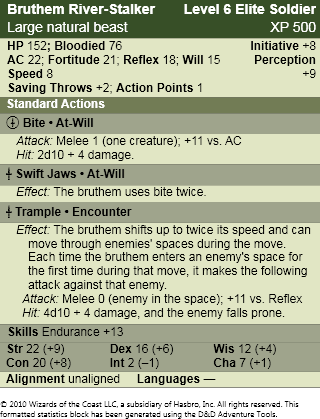
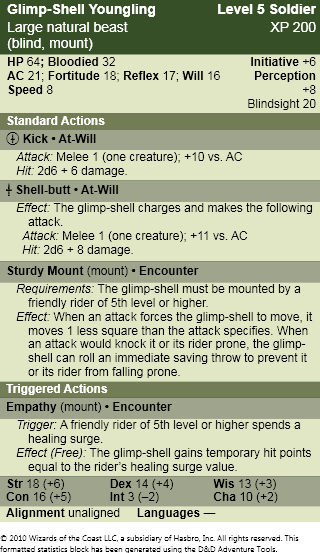

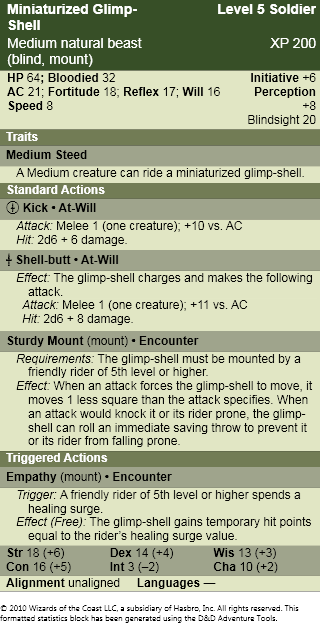
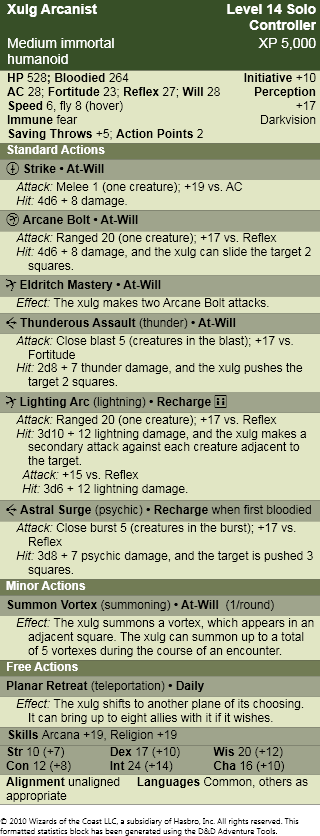
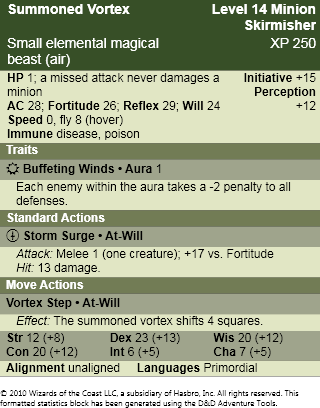
You're really going at this! They're going to have to work faster to keep one step ahead. I don't follow any forum for fourth, or even any blogs that focus on it, but this stuff needs to be hooked up somehow. It deserves attention, and of course use in games.
ReplyDeleteI'm still watching the statting with interest, and I like that the vortex is a creature. I'd love to know how many of the individual entries are pre-existing modular rules units, and how much you're creating yourself.
It's probably about 50/50.
ReplyDeleteSome creatures are just reskinned — Queen Lobster, for example, is just a dragon with a few tweaks. Others have bits and pieces culled from similar monsters — the Bruthem has stuff in common with the Spirehorn Behemoth. Others are just, "What makes sense?" Creatures that can cast spells typically get wizard powers reformatted as monster attacks.
It's a weird experience, though. Making a monster in oD&D or retroclones is all about "What seems appropriate and would be fun/interesting?" whereas 4e monster design asks that question but really marries everything to the numbers.
Strangely, though, both philosophies agree that you only need to know what a monster will do during combat to effectively run one.
Coming from World of Darkness, which occupies a middle ground between "this monster should do this and should have this many Hit Dice" and "this monster should do this and now here's a bunch of formulas to support that," making a 4e monster is a weird, clunky experience.
You're doing a great job. The Bruthem are a lot like hippopotami, but with more legs and some strange skeletal/exo-skeletal stuff going on that make them useful to craftsmen. They get hunted for their hides most often, tough the meat is highly sought after in places where people believe it to have aphrodisiac qualities or might prolong ones longevity, so it can fetch a good bit of money, if you can get it to market before it spoils.
ReplyDeleteNice job on the Glimp Shells. We have a table for different stages of growth that gives a base price-list. It was in the queue for early Feb, but maybe we'll bump it to earlier to link back to this post.
Your Vortex-as-creature is fun. You really surprised us with that one, in a great way--we have left the vortex-stuff in rough-draft because we we've been finishing-up some Ley-Line and related stuff.
Your take on building that stats for monsters is right on the money. The older, classic versions of D&D/retroclonage games are flexible and pretty much require a designer to make-up new stuff all the time. After doing a few hundred critters for 3.0/3.5, we're happier having gone back to something less restrictive and a bit more ambiguous like Labyrinth Lord. For now.
We're enjoying seeing how you convert things over and then really make them work for the newer edition. The creatures become more defined, more accessible, revealing little bits and pieces that were just hints or unspoken notions previously. It's a lot of fun.
There is something kinda nice about having a really detailed stat block for certain creatures...
...but it is also awfully nice to have some critters that can be summed-up in a simple off-hand paragraph, without a lot of stats to get in the way of whatever happens at the table.
But then we've always seen this as a game based upon imagination, not obsessive mathematical correctness.